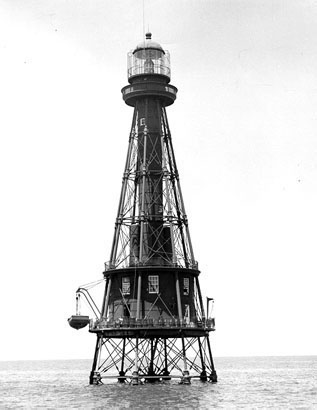Kate Walker here, tending the light on Robbins Reef at the edge of New York Harbor.

We’ve heard about the drinking water in Flint, Michigan, being contaminated by lead. Light keepers too had problems with their water supply. On September 24, 1866, Acting Engineer Max Bonzano in New Orleans informed the Light-House Board in Washington that “on Ship Shoal [Light Station] every man ever sent there lost his health, which I attribute to the lead paint on the tower and the contamination of rain water with the oxide in lead.”
How could anyone live in an isolated lighthouse several miles off the Louisiana Coast, knowing the water was contaminated?
The solution to the contamination problem was outlined in the 1867 Annual Report of the Light-House Board:
“The continued presence of sickness among the keepers at this station (Ship Shoal) led to the supposition that it was caused by contamination of the drinking water by lead washed into the rain-water tanks from the red lead paint with which the whole structure was painted. The old lead color was scraped and washed off with a solution of caustic potash. This was so perfectly successful that the whole tower looked like new iron which had never been painted. The potash solution was then rinsed off, and hot coal-tar applied in three successive coats. . . . At the same time the water tanks, and pipes leading to them, were taken down and cleaned with the greatest care, to remove every particle of sediment. The tanks and pipes were then coal-tarred inside and out, so as to envelop in the tar and render harmless any particles of lead salts which might have escaped the cleaning process. The result of the operation was that the health of the keeper and his assistants at once improved, and there has been no sickness at the place since. The importance of removing the cause of the sickness prevailing at this place cannot well be overestimated. Several persons have been paralyzed, and this fact becoming known was likely to deter anyone from accepting the position of keeper.”
 Information is taken from National Archives Record Group 26, Entry 5 (NC-63) and several Annual Reports of the Light-House Board.
Information is taken from National Archives Record Group 26, Entry 5 (NC-63) and several Annual Reports of the Light-House Board.
Submitted October 10, 2017
* * * * *
U.S. Lighthouse Society News is produced by the U.S. Lighthouse Society to support lighthouse preservation, history, education and research. Please join the U.S. Lighthouse Society if you are not already a member. If you have items of interest to the lighthouse community and its supporters, please email them to candace@uslhs.org.

